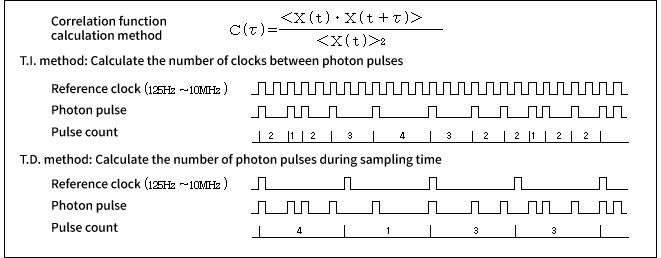Introduction:Particle size measurement of fine particles
4.Features of photon correlation method
Table 2 shows a comparison of the photon correlation methods. The photon correlation meter used in our instruments is a software method. Our dynamic light scattering photometer and zeta potential analyzer incorporate both the T.I. method and the T.D. method and are considered for accuracy in a wide range. The conventional T.I. method has good accuracy when the light is weak and the particle size is small, and the T.D. method enables high-precision measurement when the particle size is large, and the amount of light is large. Figure 14 shows each calculation method.
Table 2. Comparison of photon correlation methods
| Photon Correlation Method | Advantages | Disadvantages | |
| Software method (The number of photons counted by the hardware is stored in the memory, and the correlation function is obtained by adding, subtracting, and multiplying by the software (CPU).) | Time interval method (T.I. method) | To see the change in the number of clocks between photon pulses, sampling time can be reduced, time resolution and distribution accuracy are good | Difficult to deal with large particles and long correlation. |
| Time domain method (T.D. method) | Since the change in the number of photon pulses during the sampling time is observed, it is easy to deal with long correlations, and the accuracy of large particles is high. | The measurement efficiency decreases when the amount of light is weak. | |
| Hardware method (counts the number of photons at a predetermined gate and calculates the correlation function by adding, subtracting, and multiplying electrically (shift register)) | Shift register method | Output of the correlation function in real time is possible (correlation time = measurement time) ) Short dead time (50nsec) | Accuracy is reduced when the amount of light is large or weak. The function is fixed due to the hardware configuration, The number of data channels is small, Impossible to retain an irregular data removal (dust cut) function due to dust |

Figure 14. Calculation method of T.I. method and T.D. method
The nanoSAQLA and ELSZ series are based on the TD method and employ a new correlation meter that covers the disadvantages of both the conventional TI and TD methods. The features are described below.
Covers correlation time of 1 μsec to 1 sec with one measurement (measurement conditions are the same)
Calculates particle size at 2-second intervals
Maintains dust cut function
Measurement efficiency (ratio of data acquisition time to measurement time) is achieved nearly 100% ( High-precision measurement in a short time)
In this way, the new correlation meter can ensure the same or better accuracy than the two conventional methods.


 Close
Close

